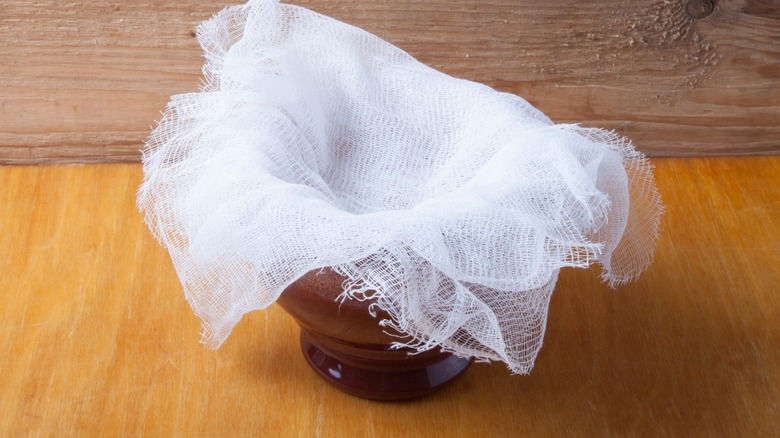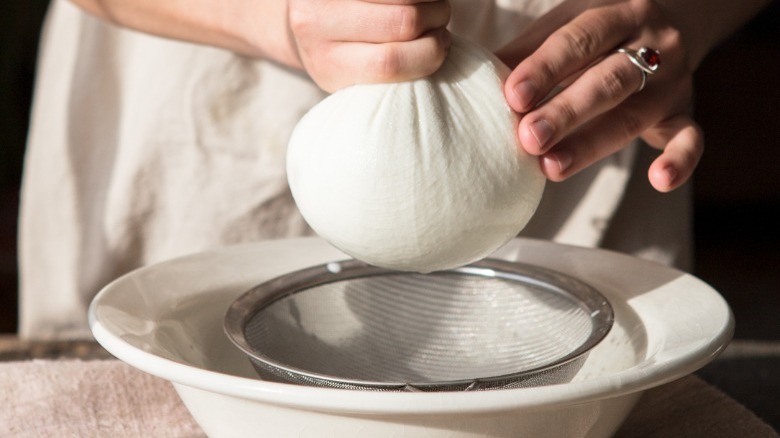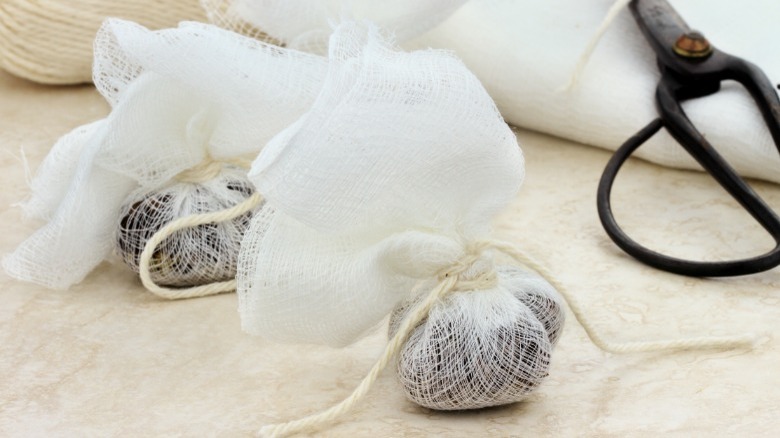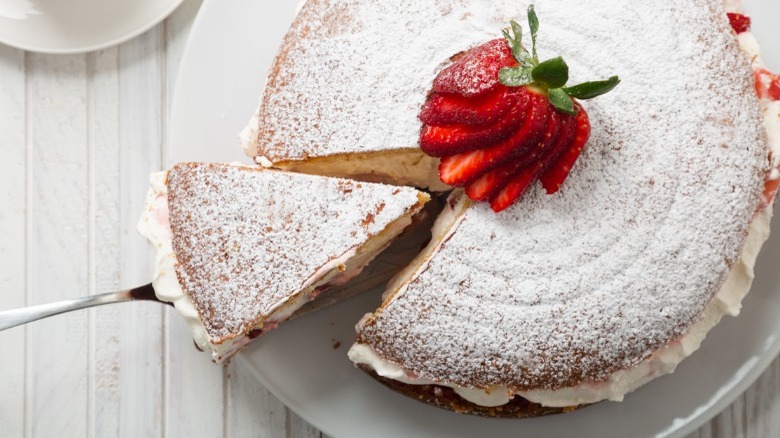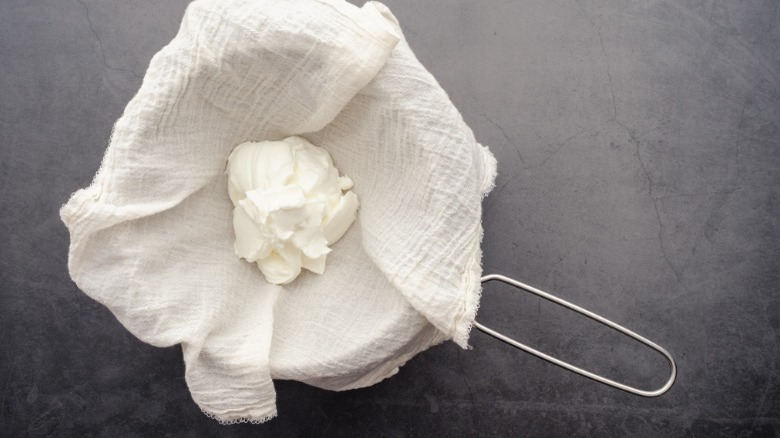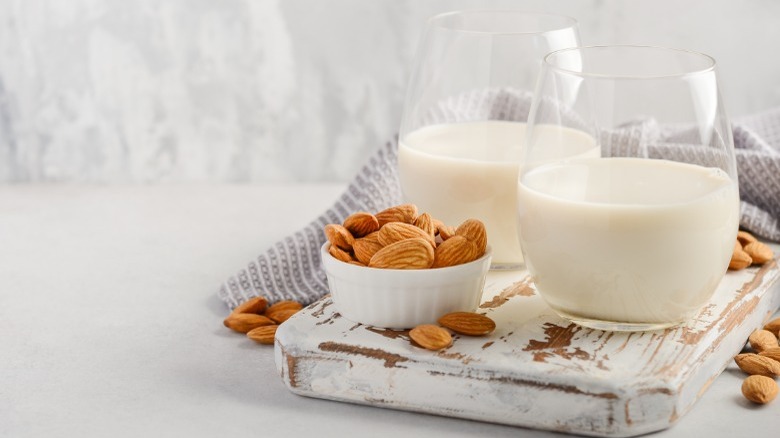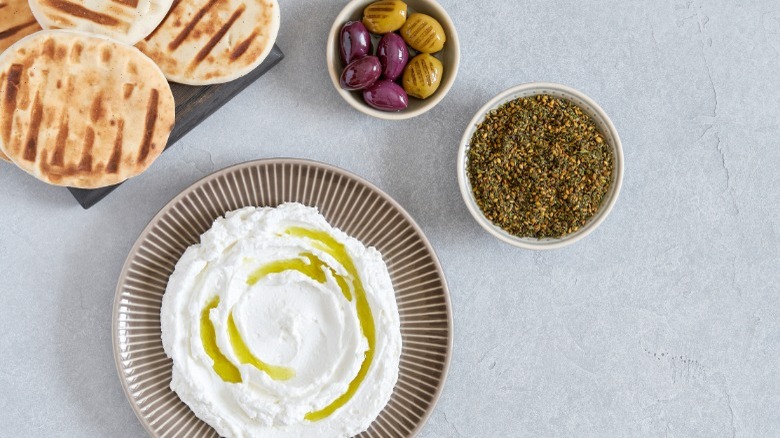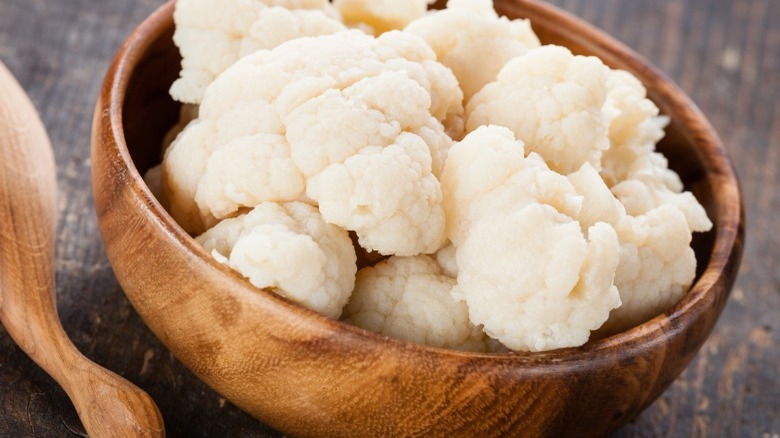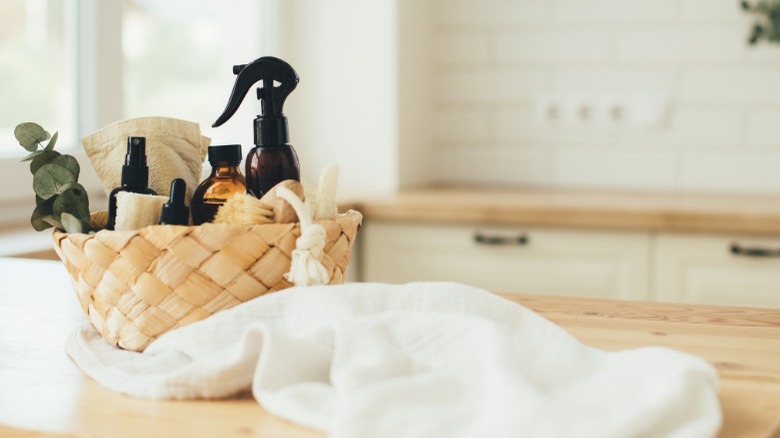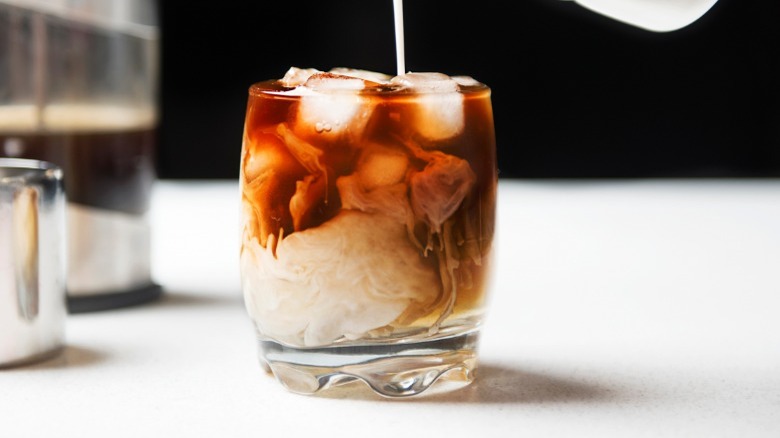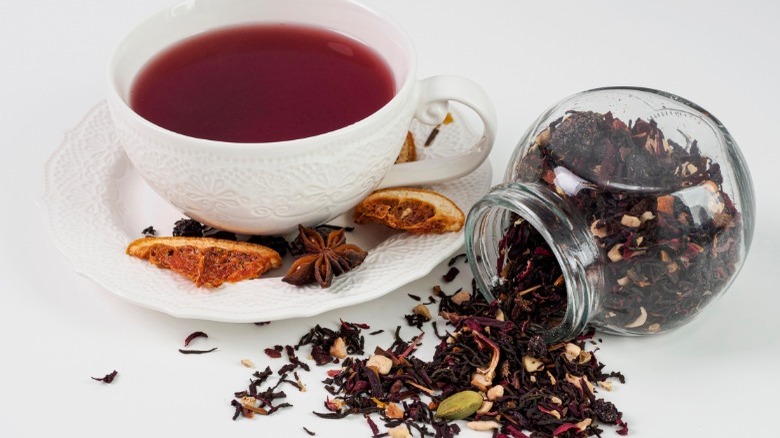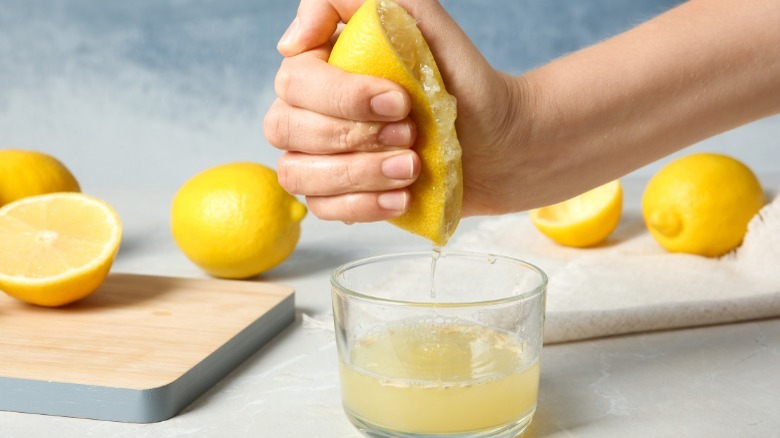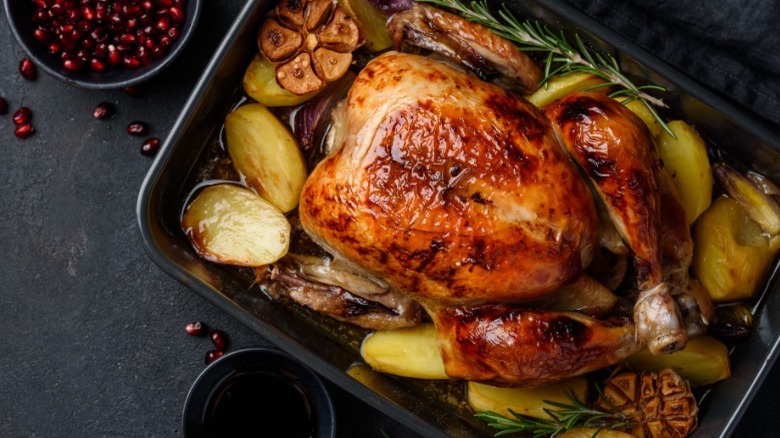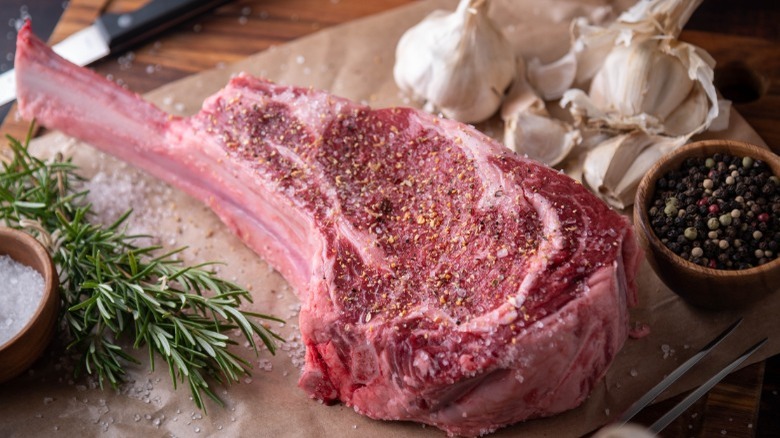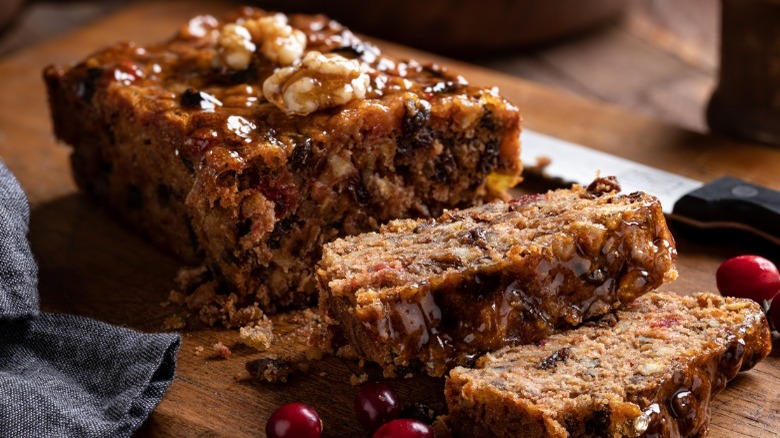15 Ways To Make The Most Out Of Cheesecloth In Your Kitchen
Most kitchens come equipped with old reliable tools and appliances you just couldn't live without. We all have our beloved favorites like that sacred knife collection or the heirloom cast-iron skillet you've seasoned time and again. Along with all your favorites, though, are a slew of random gadgets and gizmos you seldom use.
Cheesecloth might be one of those. While the name suggests that it might only make cheese, this humble fabric can do so much more. Beyond all the fancy recipes you'll appreciate having cheesecloth for, like dry-aged steaks and labneh, there are several practical ways to use cheesecloth that just about any home cook could find handy. If you have a large stash of it hidden in your cupboards, we can help with some inspiration for the culinary cloth. From squeezing lemons (without losing those slippery seeds) to whipping up a homemade cold brew coffee, we have 15 ways to use cheesecloth in the kitchen.
Make cheese
Unless you're vegan or have a dairy allergy, cheese is one of those ingredients that always happens to make its way to the grocery list. Whether you need a block of gruyere for your homemade mac and cheese or it's homemade pizza night, and a ball of fresh mozzarella is required to get the job done.
But, have you ever taken a moment to think about the cheese-making process? You might be surprised to know the amount of milk it takes to make cheese. As crazy as it sounds, you need about 10 pounds of milk to make just 1 pound of cheese — holy cow!
There are, however, plenty of smaller recipes that require much less milk. For example, if you want to make homemade ricotta cheese, you'll only need 4 cups of milk, plus some salt and lemon juice. It's as simple as heating your milk, adding lemon juice (to curdle the milk), then straining it with cheesecloth until it has thoroughly drained. Mix that with a spoonful of pesto, and you are on your way to the richest, most flavorful ricotta your baked lasagna could ever profit from.
Bundle up some herbs
A bouquet garni is a small bundle of herbs traditionally consisting of parsley, bay leaf, and thyme. The culinary combination of herbs serves an excellent purpose when you need to flavor simmering liquids without fishing out thick herbaceous stems before serving. Sachets are very similar; however, they hold more than a traditional bouquet combination. You'll find peppercorns, garlic cloves, and other spices or herbs in the little pouch. It's as simple as gathering some herbs and wrapping them with cheesecloth and twine to ensure they won't wilt away and break apart.
Next time you'd like to add great flavor to your soup, stew, or sauce without worrying about searching for stray bits before serving your dish, consider making a bouquet garni or spice sachet. Mussels escabeche is just one of several recipes where a spice sachet makes a great addition. Coriander seeds, black peppercorns, jalapeno, and lemon thyme all make their way into the little cheesecloth sachet instead of directly into the pot. The dish will gain plenty of flavor without anyone ever having to bite into those bold ingredients.
Dust your pastries
There are several things you can do to take your pastry-making skills up a notch and make yourself look like a pro. Whether you understand the importance of a crumb coat before frosting your cake or you finally nailed that perfect citrus glaze over your patisserie-style fruit tart recipe, little details go a long way. Dusting your sweet desserts with powdered ingredients is one of the simplest ways to amp up your pastries.
Simply cut a piece of the cheesecloth, then fold it once or twice over and add a small amount of your powdered ingredient of choice in the center. Pull up the corners, and feel free to tie the ends with twine. When it's time to dust, simply hold the cheesecloth over your dessert and softly tap the sides to allow the powder to fall over.
A classic French apple tart is just one of several desserts that look amazing with a light dusting over the top. You can also dust chocolate cakes with powdered sugar or white cream frostings with cocoa powder or cinnamon. Just keep in mind that powdered sugar will melt and dissolve if placed over a wet surface, so be sure to dust right before serving.
Use cheesecloth as a strainer
Considering cheesecloth is filled with several tiny holes, you will find the fabric beyond useful for straining purposes. Whether you're working on a classic chicken stock or your immune system is crying out for a hot bone broth, cheesecloth seriously comes in clutch. One thing you'll notice with bone broths is the bits of foamy floaties that come to the surface. If you don't have a small fine mesh strainer to skim the foam from the top, feel free to wrap some cheesecloth around a large serving spoon and use that instead.
Otherwise, when it's time to separate those bones and aromatics from your hot liquid gold, you will want the help of some fine mesh material. Simply place a layer or two of the cloth over a large colander or strainer, then put the sieve inside a large bowl or stock pot. From there, pour your cooled stock through the cheesecloth covering the strainer. You'll notice all those tiny bits (which you won't want in your stock) will get caught by the cheesecloth.
Make nut milk
These days it seems like the milk section has been taken over by nut, rice, and oat alternatives. You can even find banana milk on the shelves. Whether you have dietary restrictions that keep you from drinking cow's milk or you simply enjoy the taste of milk substitutes when cooking, you can't deny having more options is nice.
Believe it or not, making nut milk is easier than you may think. It is as simple as soaking nuts, then draining, rinsing, and blending them. But, before it transforms into a smooth and palatable consistency, all that nut pulp must be strained. The straining process is typically done using a reusable nut milk bag, which is often constructed with the same material as cheesecloth. Otherwise, using a large piece of cheesecloth works very well, too. After blending your nuts to a pulp, pour your liquid and blended nuts over a cheesecloth-lined fine-mesh sieve, then work to squeeze until all the nut milk is excreted.
From there, pour yourself a glass or make a big bowl of warm, nutty oatmeal topped with fresh berries and a drizzle of maple syrup.
Thicken yogurt and make labneh
If you love Middle Eastern cuisine, then there's a good chance foods like hummus, falafel, and baba ghanoush make their way to the top of your favorites. Amongst the mains, there's one effortless dish you ought to try that is also found on Middle Eastern tables: labneh. The thick, tangy spread, which is said to resemble cream cheese or sour cream, is super simple to make and worth the long wait.
The best part is homemade labneh requires only two ingredients to make it. All you need to do is combine plain full-fat yogurt (non-Greek is best) with salt and place it on the cheesecloth-lined strainer for about two days in the refrigerator until all the moisture is drained. Next time you have guests over, consider serving a fresh dish of labneh drizzled with extra virgin olive oil alongside a plate of hummus and some warm pita bread. It will surely keep your friends happy and well-fed.
Squeeze water out of cauliflower
By now, you have likely heard about all the benefits that cauliflower brings to the kitchen. Besides being a low-carb substitute for potatoes, there are so many healthy cauliflower recipes, like pizza, tater tots, and more. You can substitute rice with a steamed bowl of riced cauliflower or take a break from chicken and make Buffalo cauliflower "wings" instead. Even if you're craving baked macaroni and cheese, the humble white vegetable comes in and subs out those elbows like no other ingredient can.
However, one thing you'll notice is how much water cauliflower tends to hold. If not adequately strained, some recipes won't come out quite right. Cauliflower pizza crust is a perfect example. After you have roasted cauliflower, you'll need to let it cool, then strain it over a clean chicken towel or some cheesecloth. Instead of letting gravity do the work, you'll want to use both hands to squeeze as much liquid as possible. After a solid arm workout, you'll be left with a dry ball, perfect for forming a low-carb crust.
Clean your kitchen
Cheesecloth might be super convenient for food prep and cooking, but it's also quite handy during spring cleaning season. According to Chicago Tribune, the soft gauze-line material works well for dusting furniture. A little water to dampen the cloth is all you will need to make your furniture gleam again. Thanks to the crepey texture in cheesecloth, it works beautifully for catching dust and cleaning most surfaces.
You'll also appreciate its lint-free structure when it's time to wipe down windows and other glass surfaces. Rather than wasting time with linty paper towels, you'll find a streak-free finish when you use cheesecloth instead. If you have silverware to polish or stainless steel surfaces that need a soft touch, your cheesecloth will get you there in no time. While you can use and reuse cheesecloth for cleaning purposes, be sure to keep your new cleaning rags separate from the ones you would use to cook with.
Make a summertime cold brew
We all love the bitter-free and sweet touch of a bold cold brew coffee in the warm months, but did you know making it from home is super easy? Not only does brewing your own save time in the morning before work, but you'll save a few bucks for every cup you make from scratch. It's essential to always start with quality beans (locally roasted is best) and grind them up to the coarse ground. From there, all you have to do is pour the grounds into a container and fill it with cold water. After it has been refrigerated overnight, you'll be closer to that perfect brew.
Since nobody likes coffee grounds in their coffee, you'll need to strain the beverage well before getting to the much-anticipated sipping part. Lay some cheesecloth over a fine mesh strainer for the best results. Every speck will get caught within the tiny meshed material. Pour it over ice and enjoy the fresh flavor of a sweet cold brew.
Steep tea for a hot cuppa
Sucking down a cold brew is one way to start your day off right, but when you need a pick-me-up and you aren't feeling coffee, a warm cup of tea fulfills those needs. The soul-satisfying feeling you get when that first sip of hot tea. Plus, there are many suggested benefits linked to drinking black tea, like the potential for a lowered risk of heart disease and improved gut health (per Healthline). Of course, those benefits might weigh out if you fill your tea with lots of table sugar.
There are several ways to make loose tea without any teaware. If you can't find your tea ball, or you don't have a small fine-mesh strainer, cheesecloth works just fine. Craft a small teabag by cutting out a 3-inch by 3-inch piece of cheesecloth, then place a small number of loose tea leaves in the middle. Pull the corners up and tie them with some culinary twine, then steep it in hot water as your normally would. Pretty neat.
Keep track of your lemon seeds
Lemons are possibly one of the most overlooked flavoring ingredients you could buy. We're so quick to grab the salt and pepper to finish our meal, but there's something special about how freshly squeezed lemon juice adds brightness to a dish.
If you have a rich meal like fried fish and chips, the acidity from the lemon juice will help cut that heaviness and provide a crisp, clean taste for your palate. You'll also find lemon juice remarkably beneficial when it's time to cook chicken. Along with providing a lovely fresh flare to your poultry, lemon juice helps to break down the proteins, making the poultry incredibly tender.
There are loads of tips you need when cooking with lemons, and one of our favorite tips comes with the help of some cheesecloth. When it's time to squeeze lemon over a dish, don't worry about popping out any seeds. Instead, wrap the halved lemon with cheesecloth and give it a generous squeeze without worrying about searching for those seeds later. This is especially helpful if you don't have a lemon juicer on hand.
Roast a perfectly moist chicken
Cooking up a perfectly moist chicken or turkey roast is harder to achieve than some might think. Because the lean breasts sit on top, and the darker meats hide underneath, you'll notice that the breasts reach a safe internal temperature sooner than other parts of the chicken. If you wait for the thighs to cook to 165 degrees, you'll undoubtedly end up with some depressingly dry meat. Luckily there are a few tried-and-true ways to combat this from happening, and we bet you would never have guessed cheesecloth would get you there.
Martha Stewart suggests covering your turkey (or roast chicken) with butter-soaked cheesecloth while cooking in the oven. Stewart even says that a clean t-shirt works if you don't have any cheesecloth on hand. To obtain her perfect roast turkey, she recommends soaking four layers of cheesecloth with butter and white wine and then draping it over the top. The buttery-soaked cloth will help keep your bird moist while it cooks and prevents it from browning too soon.
Go gourmet with a dry-aged steak
If you've ever noticed dry-aged steaks on the menu of your favorite steakhouse, at a glance of the menu, you'll see that it will cost you a pretty penny to order one — but for a good reason. It's one of those surprisingly delicious things all meat lovers should try at least once (or twice).
Just like you'd age cheese to help it develop a full-bodied flavor, you can do the same with quality cuts of beef. Dry-aging makes a steak taste better because the enzymes in the meat break down, producing a much more tender steak. Plus, as water comes out of the beef during the aging process, the flavor deepens and becomes more intense.
To dry-age a steak, a chef will typically wrap a piece of beef with cheesecloth to help absorb the moisture loss from the beef. The gauze-like design of cheesecloth allows air to reach the meat, which is an integral part of the drying process, without letting it dry out too much. Without the proper designated refrigerator space and air circulation, it's probably best to let the professionals dry-age steaks; although, it's doable from home.
Keep the bugs out during a barbeque
If you live in a particularly buggy area, you know how pests can be when you have food outside during a barbeque. Between the fruit salad, sugary desserts, and all those tasty appetizers, those happy insects will love devouring your display of delicious foods. Believe it or not, cheesecloth is excellent for keeping all those flies out of your pies. Because cheesecloth comes as one large piece meant to be cut, you can place the one massive sheet over your entire food table. Otherwise, you can cut several sheets to fit over bowls.
Just like hikers use face nets to keep the mosquitos from feasting on their faces, a cheesecloth will do the same to protect your food. Cheesecloth is especially valuable for protecting big bowls of fruit punch, which naturally attract flies and other icky bugs. Nobody wants to see floating bugs in their drink.
Feed fruitcake
Fruitcake is best known for being the laugh of the season, but if done right, it can be pretty tasty. Whether fruitcake is a classic for your family's Christmas party or you've always wanted to try making it yourself, there are a few things you should know: When making a fruitcake recipe, you always want to use quality ingredients and don't forget to soak the fruit and nuts overnight to ensure they are soft when placed in the cake batter. Another thing you want to remember is to keep your fruitcake moist to ensure it doesn't turn dry and tough.
One of the best ways to maintain moisture is with the help of, you guessed it, cheesecloth. All you have to do is feed the fruitcake. "Feeding fruitcake" means to poke small holes and pour liquor over the top, then cover it with some cheesecloth. The cheesecloth will work to keep in all that fruitcake deliciousness.
